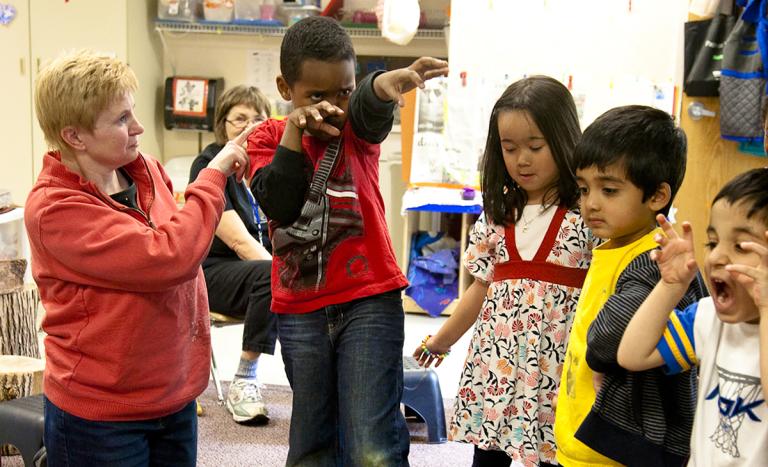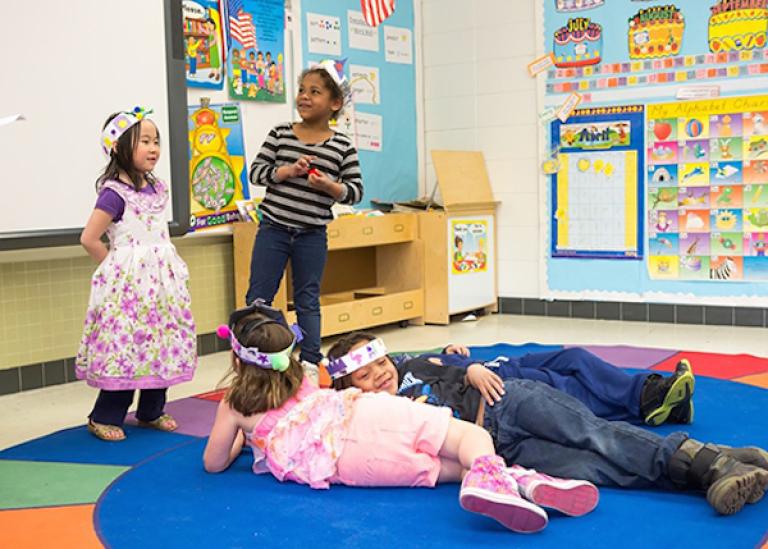Setting the stage for learning

SUPPORTING EARLY LITERACY THROUGH THEATER ARTS
The preschool class sits in a circle, eyes glued to Emily, one of the adults in the ring. Emily is a theater artist casting characters for a play.
“Would you like to be the pegasaurus?” she asks one child, who nods before she turns to another. “And would you like to be the baby hegasaurus?”
After one student is selected for each of several imaginary-dinosaur roles, the children stand in the middle of the circle, center stage, and await their cues. Emily then begins reading the script. It’s a story imagined by one of the student performers, for the children to act out in real-time.
This scene describes a session of Early Bridges, a preschool theater arts outreach program developed by the Minneapolis-based Children’s Theatre Company (CTC). Early Bridges aims to build early literacy through interactive storytelling and theater arts.
And with the help of the Center for Early Education and Development (CEED)—part of CEHD’s Institute of Child Development—participants are showing that Early Bridges not only builds literacy but also promotes the types of social and behavioral skills needed for lifelong learning.
Play is learning
For children, play is a gateway to new worlds, characters, adventures, and friendships. But beyond having fun, when children play, they are building connections in their brain that are critical to cognitive, social, and emotional development.
“The range of what children have to learn is so vast—it’s not just ABCs,” says CEED research associate Amy Susman-Stillman, Ph.D. ’97.
“Through play, they’re addressing social relationships, learning facts about the world, and problem-solving.”
Acting is out
Early Bridges grew out of CTC’s Neighborhood Bridges program in 2009. Neighborhood Bridges is a classroom-based program that supports development of literacy skills in older children through storytelling and creative drama. Now, seven all-day pre-K classrooms in Saint Paul Public Schools offer Early Bridges.
In partnership with classroom teachers, CTC teaching artists lead Early Bridges sessions throughout the school year. Each artist is trained to use developmentally appropriate techniques to engage preschool-aged children—for example, open-ended dialogue and modeling gestures to explain vocabulary and characters’ actions.
Sessions include student acting, storytelling, puppeteering, songs or chants, and time to inquire or explore. For inspiration, sessions draw on fairy tales, legends, fables, and other types of stories that highlight themes such as cooperation, respect, and kindness.

Stories by students also take center stage. Outside of the Early Bridges sessions, students tell their own stories to their classroom teacher, who writes them down. During the sessions, the teaching artist reads their stories aloud, and then they are acted out with classmates.
Maria Asp is the Neighborhood Bridges program director and an Early Bridges teaching artist. According to Asp, the program encourages young children to become the storytellers of their own lives.
“When you listen to someone’s story, you’re telling them that their ideas matter,” says Asp. “Kids need to be heard, whether their story is one word or a whole page.”
A shared vocabulary
From Early Bridges’ inception, CTC has worked to ensure it is an evidence-based program delivering maximum benefits to the children and schools it serves.
“We have to make sure that we’re doing what we say we’re doing,” Asp says. “Research helps us make sure we can be the best teaching artists we can be.”
CEED is a key research collaborator. It evaluates Early Bridges’ impact, such as whether students show improvement in certain areas. CEED also has helped develop new measures and rubrics for the program, which incorporate both theater arts and child development theory.
“The children’s theater artists and I realized we were talking about the same things but using different vocabulary,” says Susman-Stillman. For example, theater artists emphasize skills such as voice and focus, which align with early childhood skills like communicating through spoken and written word and the ability to listen and follow directions.
Success for students
According to CEED’s findings, students who participated in Early Bridges showed improvements across time in storytelling and theater arts skills such as narrative structure, reflective thinking, and collaboration. Using the measures it developed, CEED is now conducting a follow-up study that could directly link these improvements to the Early Bridges program and rule out other factors.
In addition to building skills in the classroom, Early Bridges also hopes to build community and relationships with families. Many children in the program come from low-income communities and may not otherwise have access to theater arts programming, according to Asp.
Learn more about the Neighborhood Bridges program, CEED, and the Institute of Child Development.
Story by Cassandra Blohowiak | Photos courtesy of Children’s Theatre Company | Spring/Summer 2017
“Early Bridges is an opportunity to share the theater arts experience and celebrate learning,” she says.